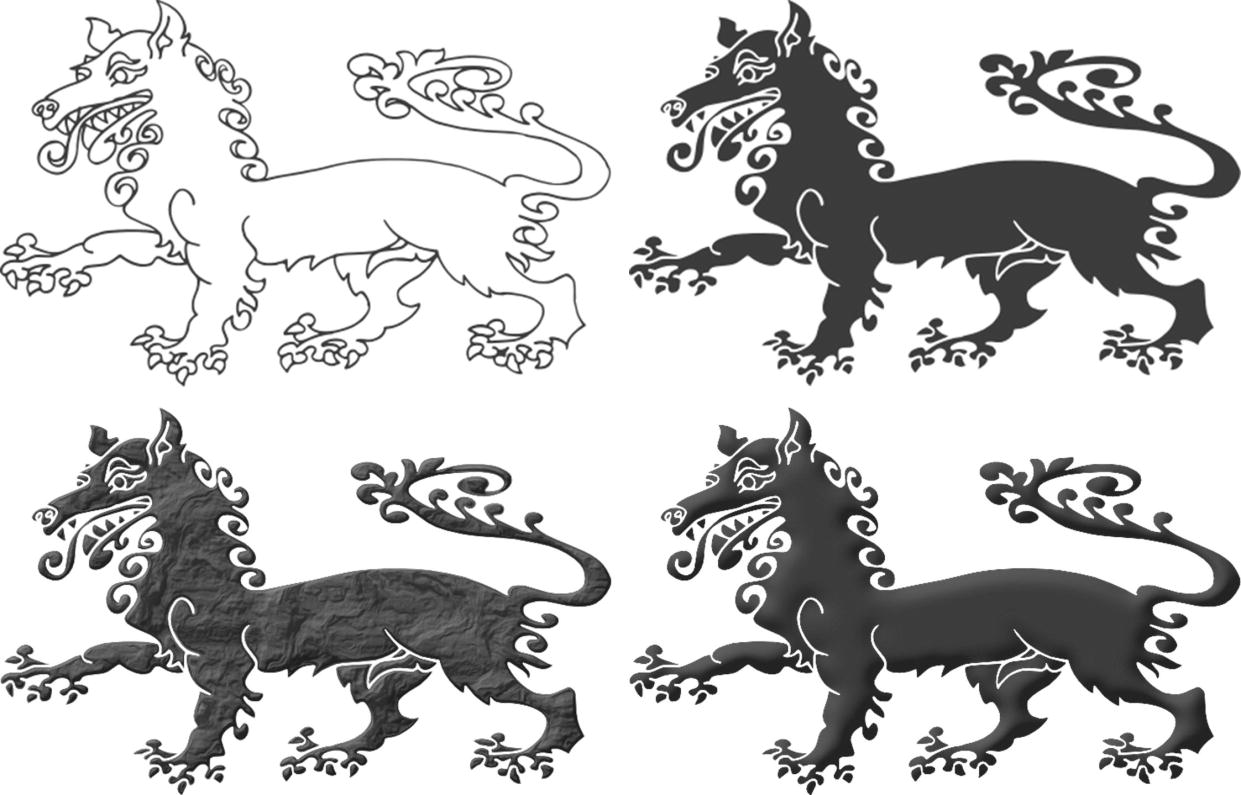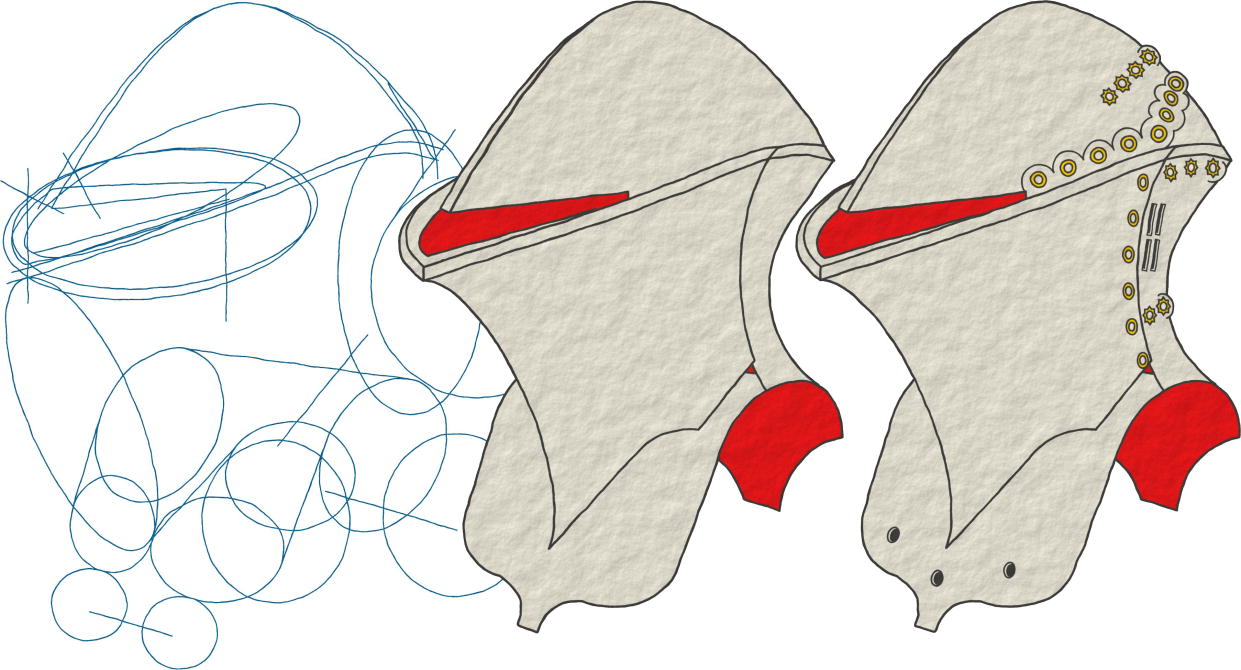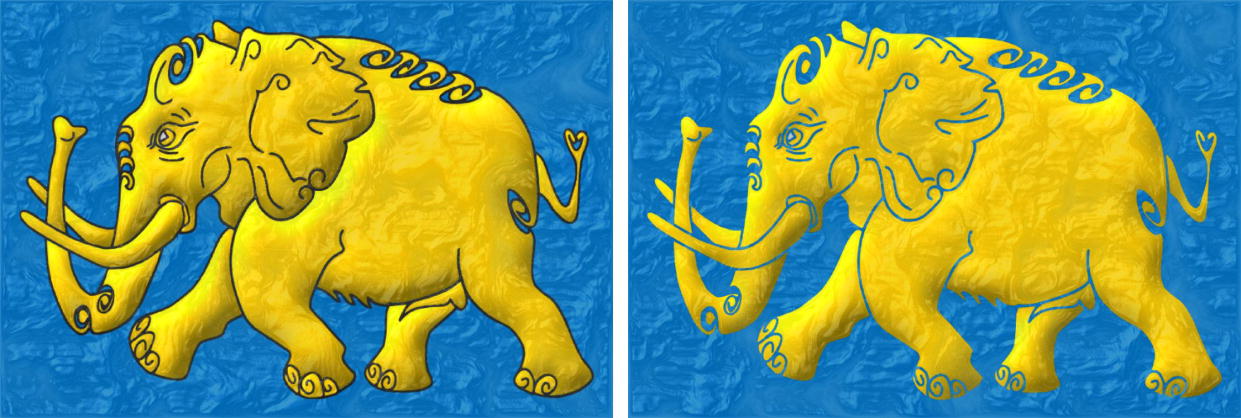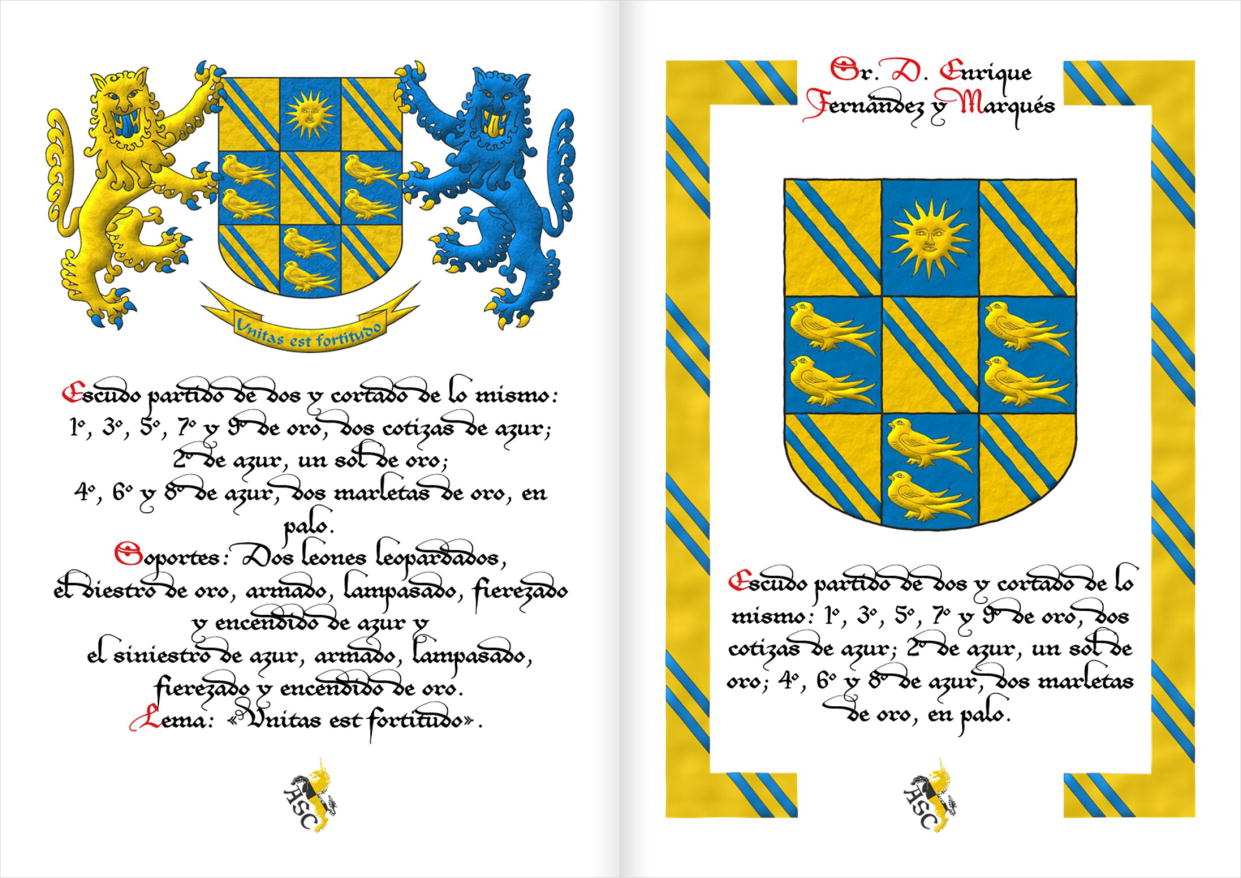
![Ver [Emblemata; 2002] en referencias bibliográficas. Libro abierto, hojas de plata, filo de oro, guardas de gules, tapas de sable.](../css/Libro.Bibliografia.png)
Emblemata; 2002
Baron of Valdeolivos Emblematic Chair, of the Fernando el Catolico Institution, of the Centre of Scientific Research (C. S. I. C.) and of the Government of Zaragoza, «Emblemata», Volume 8th, Emblemata Aragonese Magazine about Emblems (E. R. A. E.), 454 pages, 58 pictures, ISSN 1137-1056, Legal deposit Z.3.937 1996, printed by the Cooperativa de Artes Gráficas Librería General, Zaragoza, 2002.
Bibliographical reference of century XXI.
Classification: Magazine and Castilian language.
Author: Cátedra de Emblemática Barón de Valdeolivos.
External resources:
Internal resources: Emblemata2002.Volumen08.pdf.


Artistic technique in Heraldry
My heraldic art is a mixed of techniques that combine the manual realization with the digital process. The reason is that, for each specific creative activity, I try to choose the technique that best suits the goal I intend to achieve.
Drawing freehand
The natural motives are especially suitable to drawing freehand. I go through this job straight with black ink, without previous pencil schemes, with as long as possible ink traces, without lifting the pen, using 0.1 mm thin feathers, making scrolls automatically, without passing twice through the same point with the same movement. This technique comes from the automatic tracing as referred to in the third stage of the article entitled pictorial evolution and influences.
In figures with an eye I always by it and then follow by the right ear, the hair of the head, left ear, neck, back, tail, circulating at the maximum possible speed in the clockwise direction, skirting the figure to the left front leg, where I stop. Then, I do return to the right ear, down to the nose, mouth, tongue, chin, the lower part of the neck, circulating at the maximum possible speed counterclockwise, bordering the figure until the left front leg, where I stopped in the first round.
This tracing technique has the advantage of generating long lines, which seem to circulate freely, but it has the disadvantage of admitting neither mistakes nor retracings. In case of errors, the suitable choice is to finish the figure, to see the final result and be able to detect possible points of special difficulty towards the end of the tracing and right after to trace the whole figure again in a blank sheet, using the previous one as visual support. The reiterated result is to have to follow this process several times up to reaching a satisfactory level of execution. As a curiosity, I've noticed that the 1st figure often contains errors of ink path, the best is usually the 2nd and in some cases the 3rd, but from the 4th on, although there is no longer errors, the result is often more baroque.
Technical outlining
For the tracing of some figures, especially geometric, I use classic technical drawing skills. In this way vair, vairy, divisions, geometric ordinaries, bordures, checkys, etc. are calculated and outlined technically.
In some cases figures that are delineated technically are also hand-touched in order to compare techniques and be able to select the most suitable technique for the ongoing coat of arms.
Tincture of elements
In order to tincture field, ordinaries and charges I always start with plain colors and metals. In fact all my shields always have a version in plain colors. Then I build the volumes by means of lightings and shadows and applying appropriate finishings, by adding and removing hues and texturing surfaces. In some cases I do this process on the whole shield, in other, more laborious way, each field, ordinaries and charge is treated separately. This technique of working on flat base colors for later lighting and texturing follows my previous graphic work on color coated paper, which are described in the first stage of the article entitled pictorial evolution and influences.
In the final stages I try and choose the best of two options as applied to the already tinctured and finished charges:
- Represent them outlined in sable with its original layout.
- Let the tincture of the shield's field give them their final delineation.
Working process
I perform the workflow mainly over sheets size DIN, in vertical orientation, attaching to drawings annotations, metadata, samples of color, etc. I make and archive these DIN forms sequentially as I go through the steps described in the section entitled heraldic creation methodology.
At the end of the work, all of these DIN forms together, make up what could be called a «making-of» of the coat of arms, that is, the history of their creation process.


![Ver [Brian Timms] en enlaces recomendados. Áncora de oro y la divisa enlace.](../css/Ancora.Enlace.png)
Brian Timms
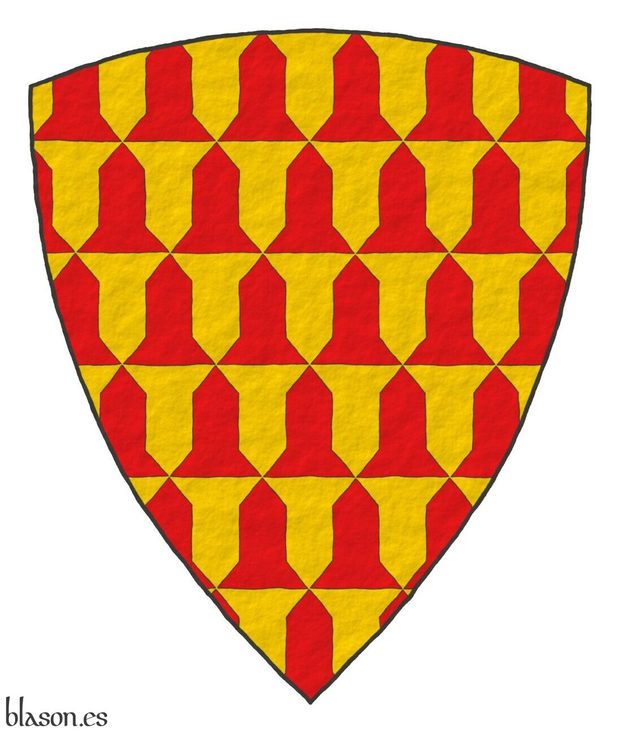
The Brian Timms website, whose domain was, «http://www.BrianTimms.fr», was absolutely admirable.
It took several visits to get an idea of the immense quantity of shields, blazons, armorials, information, and knowledge it contained, and, therefore, all the work behind it.
Armorials
Simply listing the armorials he had studied is enough to highlight the value of Brian Timms' website:
- «Caerlaverock Poem»,
- «Camden Roll»,
- [Charles' Roll; 1285],
- «Chifflet-Prinet Roll»,
- «Collins' Roll»,
- «Dering Roll»,
- «Falkirk Roll»,
- «Galloway Roll»,
- «Glover's Roll»,
- [Heralds' Roll, T.; 1280],
- «Hérault Vermandois, Armorial du»,
- «Le Rôle d'Armes Bigot»,
- «Lord Marshal's Roll»,
- «Parliamentary Roll»,
- [St. George's Roll; 1285],
- «Stirling Roll»,
- «Walford's Roll» y
- «Wijnbergen Roll».
Therefore, this website could be considered, in turn, a true armorial.
Personages and their blazons
The shield accompanying this recommended link is that of Guillermo de Ferrers ~ William de Ferrers for whose interpretation the illustration done by Brian in St. George, Part I, was consulted.
The latest personages and their coats of arms that I consulted, towards the end of March 2016, and which seemed to correspond to recent publications were:
- that of Hugh Burninghill «Sable three bats argent», which corresponded to number 5216 in his numbering,
- that of John Burton «Paly of six or and gules overall onwater budgets bendwise argent», which corresponded to number 5217 in his numbering,
- that of Thomas Burton «Sable a chevron between three owls argent», which corresponded to number 5218 in his numbering,
- that of Rafe Buxhulle «Or a lion rampant azure fretty argent», which corresponded to number 5219 in his numbering, and
- that of John Cavendish «Sable three buck's heads cabossed argent», which corresponded to number 5220 in his numbering.
These numberings would indicate that more than 5,200 blazons were reached; my other estimates indicate that this site might have contained about 5,080 blazons. In any case, Brian Timms' work can be considered prodigious.
Last visit
At the beginning of 2016, a completely renewed version was running, which ceased to be operative at the end of July 2016, corresponding to my last visit on the 20th.
My deductions about the construction of his first site, its subsequent renovation (perhaps around 2006), and my intuitions about the maintenance of this Brian Timms website were taken into account for the construction of my own website.
Category: Link.
External resource:


![Ver [Kevin MacLeod] en enlaces recomendados. Áncora de oro y la divisa enlace.](../css/Ancora.Enlace.png)
Kevin MacLeod
Kevin MacLeod provides on his website incompetech.com music licensed under a Creative Commons Attribution license, version 3.0, (CreativeCommons.org/licenses/by/3.0/).
Kevin states that there are several reasons why he offers this type of free license, for example, because the cost of sharing his music is not high and the benefits are many, and because there are music schools without funds, filmmakers who need soundtracks for their films but cannot afford them. In response to this, Kevin believes that traditional copyright is ineffective and that is why he chose a license like «Creative Commons». He believes that if creative works are protected so rigidly that they become impossible to share and his art cannot be experienced by people, then it serves no purpose in society.
The following video shows an example of a soundtrack, with music by Kevin MacLeod, for a video about a coat of arms.
Category: Link.


![Ver [Jué jù] en enlaces recomendados. Áncora de oro y la divisa enlace.](../css/Ancora.Enlace.png)
Jué jù
Jueju.es is my project to translate Jué jù poems from the Táng dynasty (from the 7th to the 10th century) and is aimed at learning the Chinese language. To this end, the translations of the poems, with meter but without rhyme, seek an isomorphism between the original poem in Chinese and its translation into Spanish.
This isomorphism allows us to associate, through a color scheme, each Chinese character and its pronunciation with 1 or 2 words in Spanish, which allows you to learn the Chinese language through its classic poets: Wáng Wéi, Li Bái, Dù Fu, Mèng Hàorán, Xi Birén, Yú Shìnán, Li Duan, Li Pín, Li Shangyin, Liú Chángqing, Wáng Zhihuàn, Zhang Hù, Zhang Jiulíng, etc.
Also, in jueju.es The poems are accompanied by vocabulary tables in simplified Chinese, traditional Chinese, pinyin pronunciation and translation into English and Spanish, drawings with pictograms and ideograms, derivation diagrams for compound characters, tonal schemes to help with the intonation of accents, explanatory texts and my own illustrations of the poems in ink and watercolor.
Below are, in PDF format, 2 pages of my translation of the poem «The Song of Geshu» by the poet Xi Birén dedicated to General Geshu Han, both of the Tang dynasty. I have selected this poem, from among the dozens that make up the project jueju.es, because it is especially heroic with its 7 stars, the night, the knife and the horses.


![Ver [Marianne Steinbauer] en enlaces recomendados. Áncora de oro y la divisa enlace.](../css/Ancora.Enlace.png)
Marianne Steinbauer
Dr. Marianne Steinbauer provides, under a conventional license, at Pia-Frauss.de exceptionally beautiful typefaces. Typefaces with such suggestive names as «MalaTesta», «MitreSquare», «SonOfTime», «Tycho'sElegy», «DeiGratia», «EtBoemieRex», «FranciscoLucas», «JaneAusten», «Love'sLabour», «Tagettes», «Tycho'sRecipe», «WirWenzlaw», «XalTerion», «Xenippa», «XiBeronne», «Xiparos» o «Xirwena».
Example of EtBoemieRex use by Dr. Marianne Steinbauer.
Personally authorized
Dr. Marianne Steinbauer has personally authorized me to use them, for which I sincerely thank her. As shown in the previous image of a heraldic catalogue where the font called «EtBoemieRex» is used.
Category: Link.


![Ver [Heraldic blog of David B. Appleton] en enlaces recomendados. Áncora de oro y la divisa enlace.](../css/Ancora.Enlace.png)
Heraldic blog of David B. Appleton
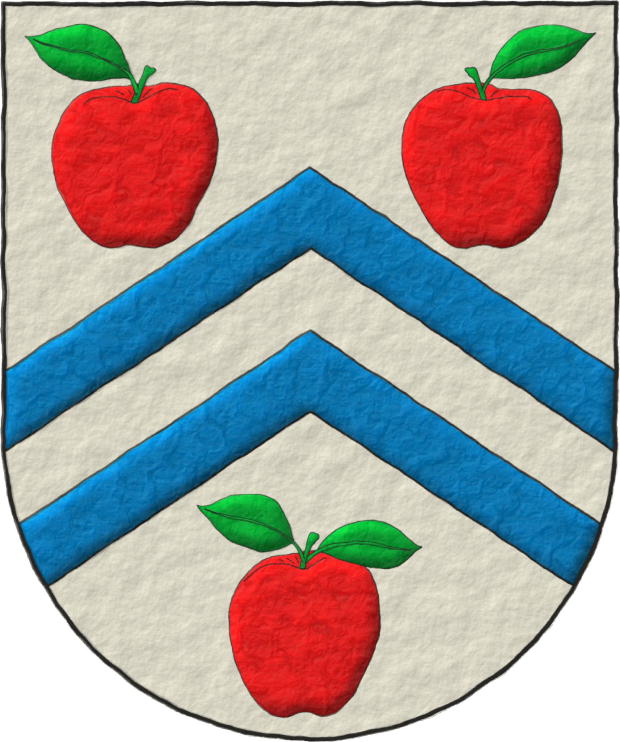
Appleton Studios
David B. Appleton studies, researches, teaches, and writes about heraldry, and through his blog, he shares his heraldic knowledge with us, as well as through publications and presentations.
David B. Appleton is open to questions from his readers and provides advice on heraldic topics in which he specializes.
His blog is Blog.AppletonStudios.com and his website is AppletonStudios.com, from which he offers his services related to the world of heraldry, its dissemination, and knowledge.
Since 2009, David B. Appleton's heraldic blog has been an endless source of knowledge, images, ideas, curiosities, original reflections, and links to heraldic sites selected by him.
Heraldry: Musing on an esoteric topic
David B. Appleton stands out for his continuous analysis of all types of heraldic manifestations, which he finds everywhere, in the world we live in: from those we have inherited from ancient times to the fiercely current, from books to cinema, from fashionable clothing to urban furniture, from east to west and north to south, including those that appear in logos and emblems, those using traditional techniques and those created or disseminated through new technologies, on ships, sports cars, and airplanes, on porcelain, facades, and stained glass, on television, on t-shirts and coins, in auctions and universities, in comics and sports, etc. with a systematic publication rhythm, more than 2 posts per week, nothing heraldic escapes the record and genuine analysis of David B. Appleton on Blog.AppletonStudios.com, which I highly recommend.
Categories: Link, Interpreted, Personal, Coat of arms, Without divisions, Freehand, Soft metal, Illuminated, Outlined in sable, Canting, Heraldry and heralds, Argent, Azure, Gules, Vert, Chevronel, Between, Apple, Slipped and Leaved.
External links:
- Interpretation of his coat of arms.
- Interpretation by Xavier García at Appleton Studios.
- Interpretation by Xavier García at Dibujo Heráldico with his blazon in English and Spanish.
Root: Appleton, David B..


Appleton, David B.
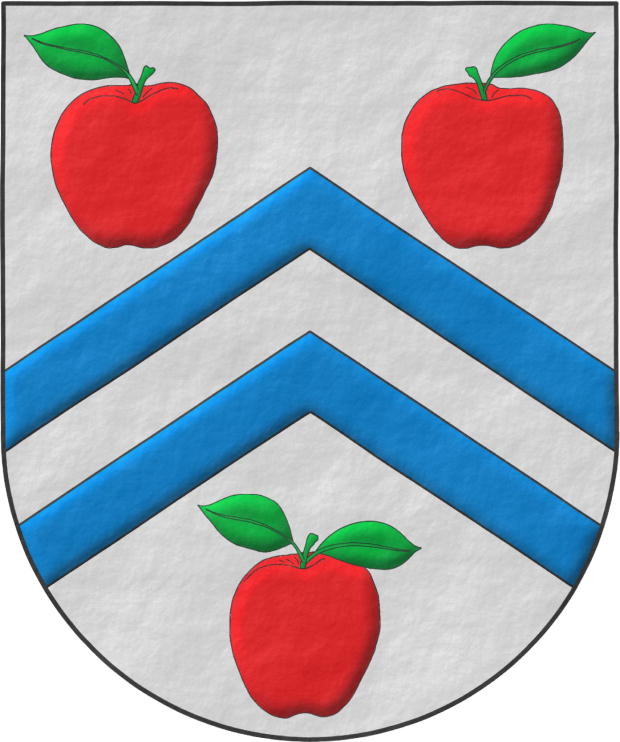
Canting arms, apple ~ appleton.
Argent, two chevronels Azure between three apples Gules, slipped and leaved Vert.
Escudo de plata, dos tenazas de azur acompañadas de tres manzanas de gules, talladas y hojadas de sinople.
Coat of arms interpreted by me with: a round-bottomed shield shape; the field in flat tincture metal Argent; the figures outlined in Sable and illuminated in Azure, Gules, and Vert; and all with a rough finish.
A summary of the heraldic blog of David B. Appleton can be found among my recommended links on the heraldic universe.
Blazon keywords: Without divisions, Argent, Azure, Gules, Vert, Chevronel, Between, Apple, Slipped and Leaved.
Style keywords: Rough, Illuminated and Outlined in sable.
Classification: Interpreted, Personal, Coat of arms, Canting and Heraldry and heralds.
Bearer: Appleton, David B..

Continue with: David B. Appleton, slipped and leaved.
-
Language
-
Categories of heraldry
-
Divisions of the field
- Without divisions
- Party per pale
- Party per fess
- Party per bend
- Party per bend sinister
- Tierce
- Tierce sinister
- Tierced per pale
- Tierced per fess
- Tierced per bend
- Tierced pallwise inverted
- Quarterly
- Quarterly per saltire
- Gyronny
- Party per fess, the chief per pale
- Party per pale, the sinister per fess
- Party per fess, the base per pale
- Party per pale, the dexter per fess
- Chapé
- Chaussé
- Embrassé
- Contre-embrassé
- Party per chevron
- Enté
- Enté en point
- Flanched
-
Metals
-
Colours
-
Furs
-
Other tinctures
-
Ordinaries and sub-ordinaries
-
Diminutives of the ordinaries
-
Geometric charges
-
Composite ordinaries
-
Inanimate charges from Nature
Atom, Crescent, Diamond, Emerald, Estoile, Increscent, Lightning flash, Moon, Mount, Mullet, Mullet of four points, Orbital, Plough of Ursa Major, Rainbow, Ray of the sun, River, Sea, Snowflake, Sun, Sun in splendour, Sun of May, Trimount, Water and Wave.
-
Vegetal charges from Nature
Acorn, Apple, Apple tree, Ash, Bluebonnet, Camellia, Chrysanthemum, Cinquefoil, Cornflower, Dogwood flower, Double rose, Elm, Fleur de lis, Flower, Gourd, Holm oak, Hop cone, Kapok tree, Laurel, Lily, Linden, Lotus flower, Madonna lily, Mexican cedar tree, Oak, Olive tree, Palm tree, Plantain plant, Pomegranate, Poplar leaf, Rose, Shamrock, Sunflower, Thistle, Tree, Tulip, Vine and Wheat.
-
Animal charges from Nature
Badger, Bald eagle, Barbel, Barn owl, Bear, Beaver, Beetle, Bighorn sheep, Blackbird, Boar, Brach hound, Bull, Doe, Dog, Dolphin, Dove, Eagle, Elephant, Falcon, Female figure, Fish, Flame, Fly, Fox, Frog, Goat, Goldfinch, Goose, Heron, Horse, Hummingbird, Jaguar, Lark, Leopard, Lion, Lion passant, Lion rampant guardant, Lioness, Lynx, Male figure, Martlet, Merino ram, Owl, Panther, Parrot, Peacock, Pelican, Pelican in her piety, Puffin, Quetzal, Raven, Roe deer, Rooster, Savage, Seagull, Serpent, She-wolf, Stag, Starling, Talbot, Tyger, Vulture, Warren hound and Wolf.
-
Parts of natural charges
Arm, Beak, Branch, Caboshed, Chest, Claw, Covert, Dorsal fin, Eagle claw, Ermine spot, Escallop, Feather, Foot (palmiped), Foreleg, Forepaw, Hand, Head, Heart, Hoof, Leaf, Neck, Ostrich feather, Palm frond, Paw, Roe deers' attires, Shoulder, Sprig, Stags' attires, Stem, Swallow-tail, Tail, Tail addorsed, Tail fin, Talon, Tooth, Trunk, Trunk (elephant), Two hands clasped, Two wings in vol, Udder, Wheat spike, Wing and Wrist.
-
Artificial charges
Ace of spades, Anchor, Anvil, Arch, Arm vambraced, Armillary sphere, Arrow, Axe, Bell, Bell tower, Beret, Bonfire, Book, Bookmark, Bow, Branding iron, Bridge, Broken, Buckle, Cannon, Cannon dismounted, Cannon port, Canopy roof, Carbuncle, Castle, Celtic Trinity knot, Chain, Chess rooks, Church, Clarion, Clay pot, Closed book, Club, Column, Comb, Compass rose, Conductor's baton, Cord, Covered cup, Crozier, Crucible, Cuffed, Cup, Cyclamor, Dagger, Double vajra, Drum, Ecclesiastical cap, Fanon, Federschwert, Fleam, Four crescents joined millsailwise, Galician granary, Garb, Gauntlet, Geometric solid, Grenade, Halberd, Hammer, Harp, Host, Hourglass, Key, Key ward, Knight, Knot, Lantern, Letter, Line, Loincloth, Menorah, Millrind, Millstone, Millwheel, Monstrance, Mortar, Mullet of six points pierced, Nail, Non-classic artifact, Norman ship, Number, Oar, Oil lamp, Open book, Page, Pair of scales, Parchment, Pestle, Piano, Pilgrim's staff, Plough share, Polish winged hussar, Port, Portcullis, Potent, Quill, Ribbon, Rosette of acanthus leaves, Sabre, Sackbut, Sail, Scroll, Scythe, Sheaf of tobacco, Ship, Skirt, Spear, Spear's head, Stairway, Star of David, Step, Sword, Symbol, Tetrahedron, Torch, Tower, Trident, Trumpet, Turret, Two-handed sword, Wagon-wheel, Water-bouget, Wheel, Winnowing fan and With a turret.
-
Immaterial charges
Angel, Archangel, Basilisk, Dragon, Dragon's head, Garuda, Golden fleece, Griffin, Heart enflamed, Justice, Mermaid, Our Lady of Mercy, Ouroboros, Paschal lamb, Pegasus, Phoenix, Sacred Heart of Jesus, Saint George, Sea-griffin, Trinity, Triton, Unicorn, Winged hand and Wyvern.
-
External elements
-
Heraldic creations
-
References
-
Formats
-
Keywords on this page
Between, Appleton, David B., Artist, Azure, Bibliography, Brian Timms, Heraldry and heralds, Outlined in sable, Link, Coat of arms, Personal, Gules, Leaved, Illuminated, Interpreted, Jué jù, Kevin MacLeod, Castilian language, Apple, Marianne Steinbauer, Soft metal, PDF, Canting, Argent, Without divisions, Magazine, Rough, Century XXI, Vert, Slipped, Chevronel and Freehand.

